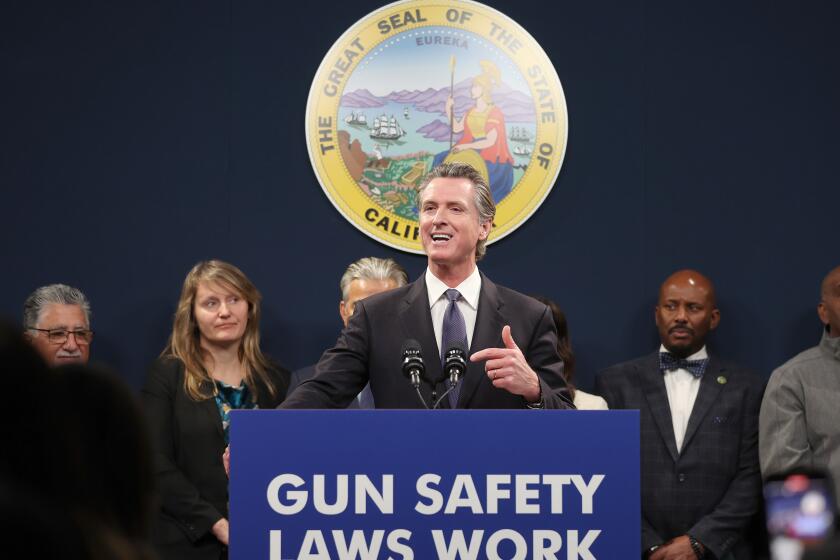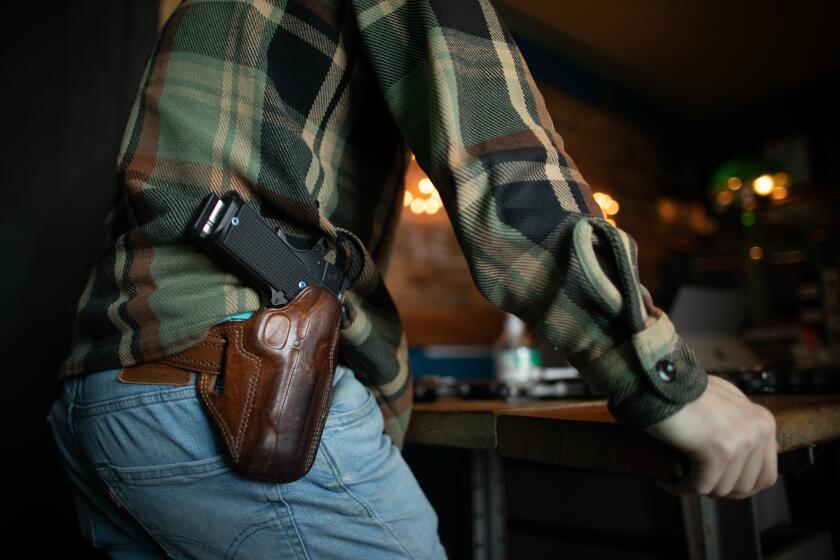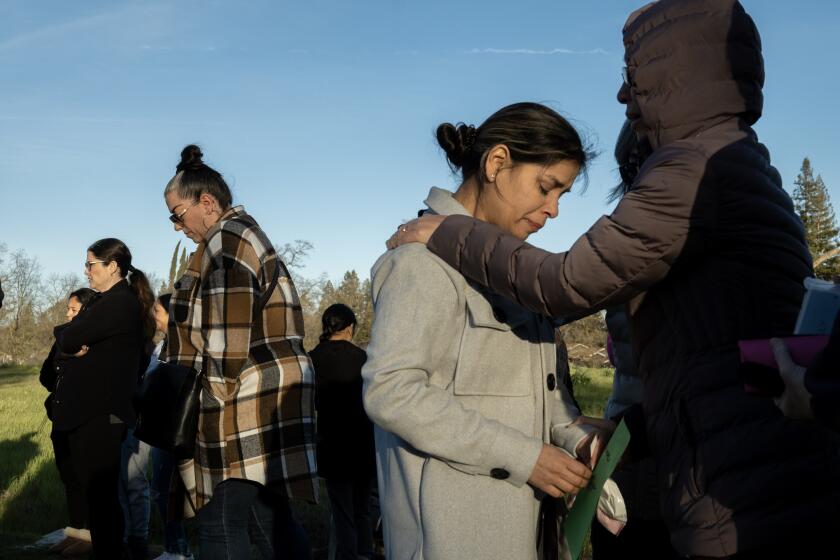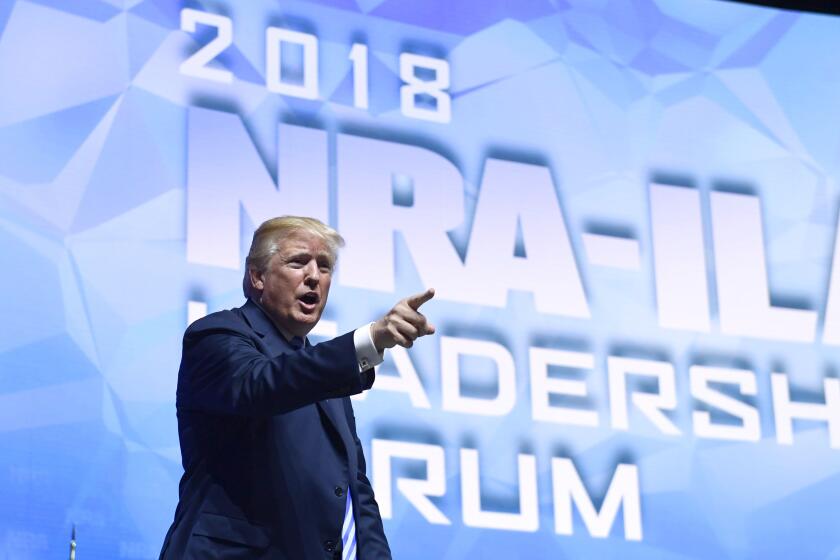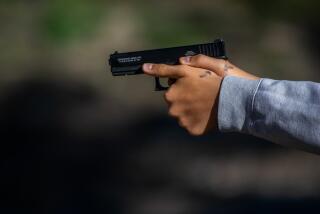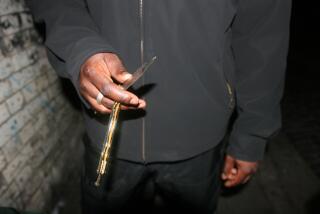Column: California says its new gun law is about public safety. But what about these women?
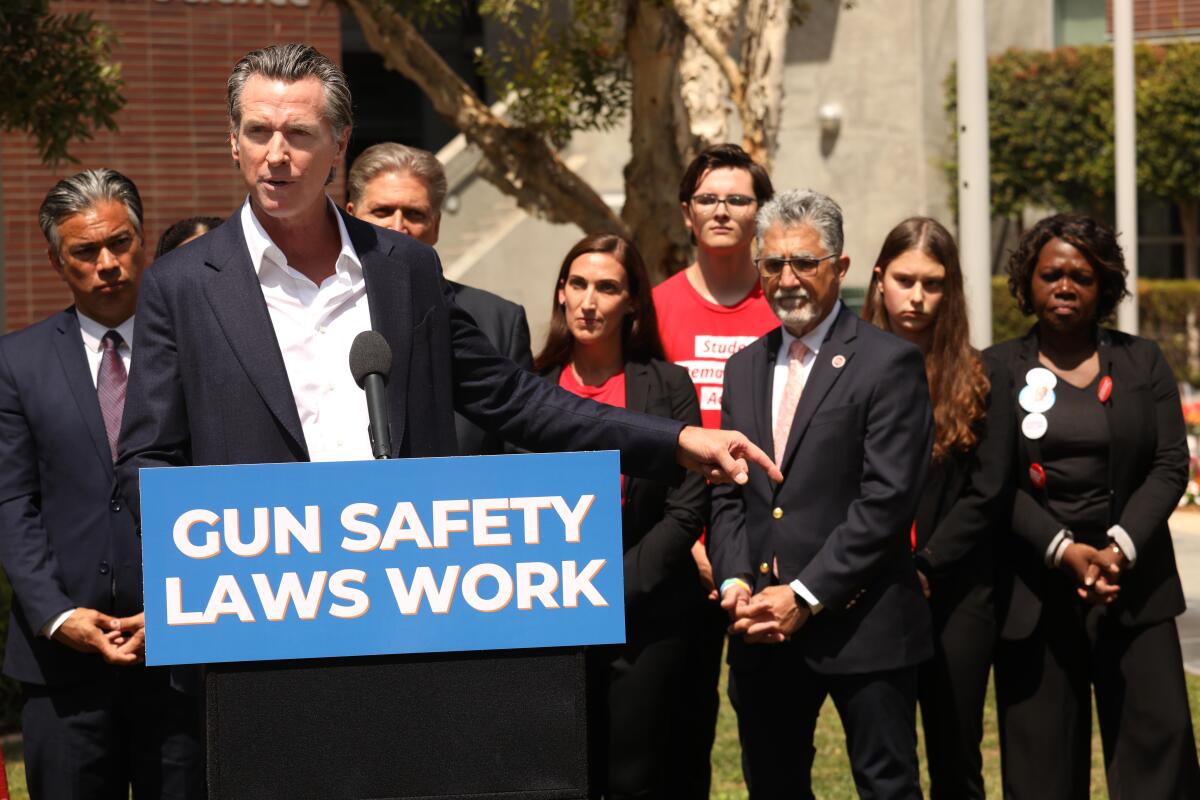
- Share via
Kismet Jackson used to carry her handgun just about everywhere in San Bernardino County. To get her nails done. To pick up her prescription. To hang out with her grandchildren.
For her, it was all about staying safe.
“Being out and about, you just want to protect yourself,” explained Jackson, an Air Force veteran and member of the National African American Gun Assn. “The biggest thing for me [is] walking to my car, and someone puts a gun to my head and tells me give them what I don’t have.”
Lately, though, she has felt anything but safe.
At the beginning of this month, after a flurry of lawsuits, California began enforcing a controversial law banning guns in “sensitive” public places. It’s a long list that ranges from parks to stadiums to parking lots to public transportation to churches to anywhere alcohol is sold to commercial buildings without signage explicitly allowing firearms.
A new California law barring licensed gun holders from carrying their firearms into many public places has once again been blocked pending an appeal.
Then, last week, after some more back-and-forth in federal court, the state was forced to stop enforcing the law — highlighting not only the political drama surrounding it but the sloppiness of how it was written.
The law, known as Senate Bill 2, was drafted as a workaround to a U.S. Supreme Court decision from 2022 that threw out a chunk of the state’s — and the nation’s — gun control regulations as unconstitutional, theoretically making it easier for people to obtain concealed-carry permits.
It was meant as a retaliatory blow to the Supreme Court, ostensibly designed to keep California from turning into Florida and other red states, where alarming permit-less carry laws mean there’s no longer anything preventing people — trained or untrained — from strapping on a Glock and heading to the grocery store.
But SB 2, sponsored by state Sen. Anthony Portantino (D-Burbank), went further than the laws that were in place before the Supreme Court’s decimation of common sense gun-control regulations.
Now, even Californians who have submitted to extensive background checks and participated in hours of training can’t legally carry their firearms without running afoul of the list of banned places — which, let’s be honest, are just about everywhere.
If the law survives this latest legal challenge, “I’ve got to leave my firearm in a locked container inside my locked car,” Jackson lamented.
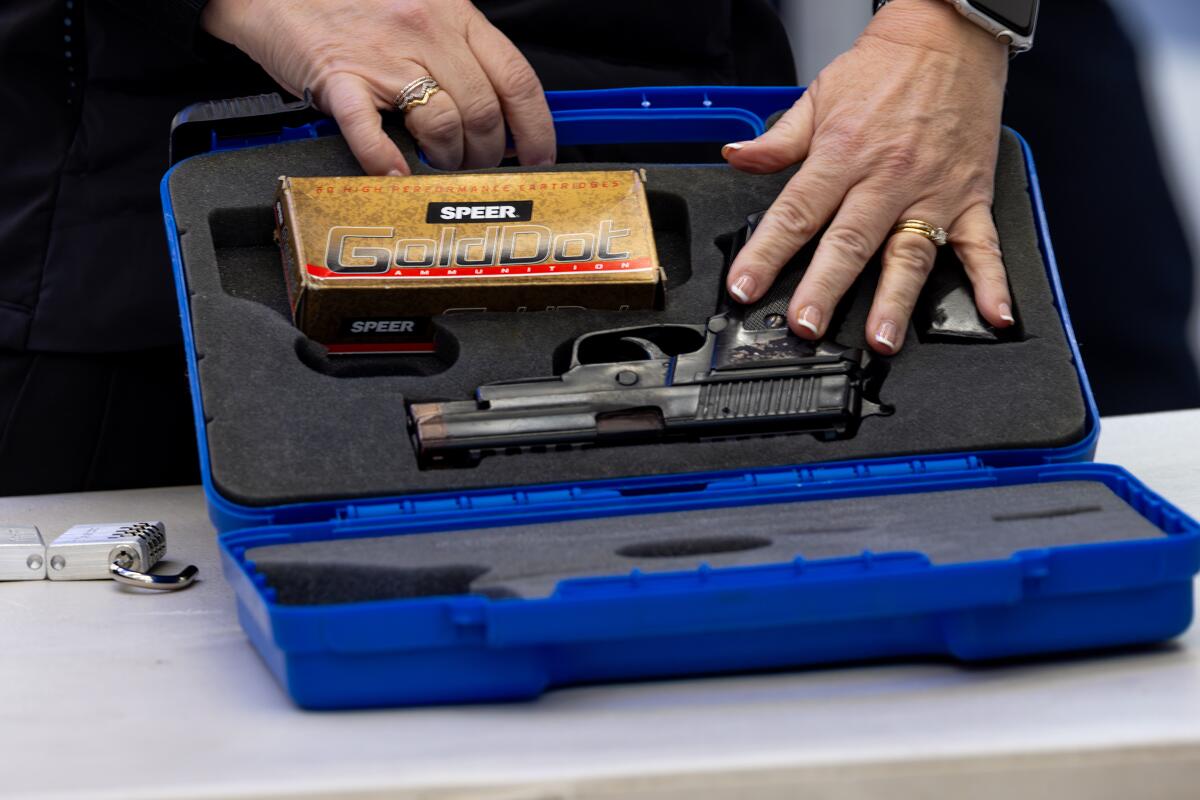
The push by California to take away her ability to legally carry a gun, after years of complying with an already-strict vetting process, has her feeling downright “shook” about her safety — and she suspects that pales in comparison to what some other women are feeling.
Women who, in an effort to reclaim their lives and conquer their fears after surviving domestic violence, decided to buy a gun and get a concealed-carry permit. Or women of color who are understandably so afraid of police brutality that they feel as if they have no choice to defend themselves from intimate partner violence.
Or, perhaps most of all, women who have been let down by a criminal justice system that is supposed to seize firearms from abusers, but too often doesn’t.
“They got a little bit of their confidence back. They felt a little more comfortable with going out in public,” Jackson said of such women. “And now [California] has just snatched that out from underneath them.”
::
You won’t find many, if any, domestic violence support groups or gun violence researchers coming out to defend women who buy guns to protect themselves — and with good reason. Statistically, it usually doesn’t work out that way.
“We don’t have any evidence that a woman who’s been abused carrying a gun makes her safer,” said Susan B. Sorenson, a professor with the University of Pennsylvania and director of the Ortner Center on Violence and Abuse. “We have a fair amount of evidence that having a gun in the home makes women less safe.”
In fact, this is true of regardless of gender. There are already more firearms than people in America, and multiple studies have shown the obvious: The more guns that are in circulation, the more likely it is that people are going to get shot, whether it be by accident, by homicide or, most often, by suicide.
A recent study by Everytown for Gun Safety designated five laws that do the most to reduce shootings overall, including background checks and red flag laws to temporarily remove guns when there is evidence that someone poses a serious risk to themselves or others.
California checks all of these boxes (though enforcement is often lacking), so Gov. Gavin Newsom is right when he boasts that our state is “using every tool we can to make our streets and neighborhoods safer.”
And there are parts of SB 2 that are good. The doubling of the amount of training needed to get a concealed-carry permit, from eight to 16 hours, for example, and deepening background checks to include social media scans and personal references.
But SB 2 is still flawed. Attempting to shadow-ban concealed-carry permits is not likely to reduce gun violence.
Democrats send Gov. Gavin Newsom a bill to restrict who can obtain a concealed-carry permit in California, teeing up a possible Supreme Court fight.
The last non-self-defense homicide committed by a concealed- carry permit holder took place in 2019 in Modesto, and the assailant was charged and convicted. The second most recent happened in 2010 — a Southern California security guard who killed his ex-girlfriend and her new partner.
In Fresno County, the sheriff said there hasn’t been a crime involving any of its roughly 12,300 concealed-carry permit holders in at least two years — and Fresno has one of the highest number of permit holders in the state.
Chuck Michel, the general counsel for the California Rifle & Pistol Assn. who filed the suit over SB 2, said the law hurts more than just women who fear for their personal safety. He points to retired judges and prosecutors who may have dangerous enemies. People in the LGBTQ+ community facing rising hate crimes. And even jewelers who routinely carry gems and cash.
“There are certainly some individual circumstances where the need for that kind of permit is profound,” Michel said.
Even if you think that’s a paranoid or specious argument that inflates the need for more guns on our streets, consider this: Despite millions of dollars and countless hours spent crafting and defending SB 2, government officials can’t — or won’t — say how many people in the state have concealed-carry permits.
A few non-government sources we found estimate there are at most 200,000 people with active permits (which are valid for only two years), and an additional 100,000 pending since the Supreme Court decision — still a small fraction of California’s 3.3 million legal gun owners.
But when we asked Atty. Gen. Rob Bonta’s office for the number of active permits in their system, they told us they would need to compile that figure and it would involve a Public Records Act request.
How do you argue this rule meaningfully reduces gun violence without even being willing to openly talk about how many people it involves?
::
What we do know from Bonta’s office is that in 2022, there were more than 23,000 active and pending cases in the state’s Armed and Prohibited Persons System, which tracks Californians who own legally registered firearms but have lost the right to possess them. About 4,000 of those cases involved a restraining order and nearly 5,000 more had to do with concerns over the owners’ mental health.
Agents with the state Department of Justice, often working with local law enforcement agencies, managed to retrieve just 1,437 guns from those potentially dangerous people that year, which is considered a success based on the abysmal statistics of previous years.
These numbers mostly don’t cover the thousands of illegal guns on our streets — ghost guns, stolen guns, unregistered guns in the hands of felons.
Meanwhile, also in 2022, emergency dispatchers received more than 160,000 calls about domestic violence, 2,100 of which involved a firearm. In the decade ending in 2022, 782 women were shot and killed by domestic abusers.
This is one reason why so many domestic violence support groups discourage survivors of intimate partner violence from buying guns, pointing out that an abuser can easily turn that gun on them.
But women who don’t feel safe might do so anyway. And they don’t feel safe because government has failed to take domestic violence seriously enough to devote enough resources to stop it, often leaving underfunded nonprofits to pick up the slack with counseling services and violence prevention programs.
This is especially true for Black and Latino women, who are disproportionately victims of intimate partner violence and human trafficking and often caught in a nexus of poverty, housing insecurity, systemic racism, sexism and overpolicing. It’s why cases like that of Niani Finlayson, who was shot to death by an L.A. County sheriff’s deputy in December after calling 911 to report that she was being attacked by an ex-boyfriend, are so chilling.
“I would dissuade any woman, particularly a woman who has children, from buying a firearm. That’s like the leading cause of death for very young children,” said Sikivu Hutchinson, founder of the Women’s Leadership Project in South L.A.
But she said she “absolutely understands it” as “a response of desperation and crisis.”
Indeed, if some women have turned to arming themselves, it’s hardly ideal because of the dangers, but it unfortunately makes some sense — in California and across the country. Taking that right to carry away, whether it is offering real or only perceived safety, is another psychological harm piled on top of unforgivable policy failures.
David Mora shot and killed his three daughters and a chaperone during a supervised visit last year. The children’s mother warned the courts he was dangerous, but no one listened.
“It makes me sad,” Maggie Martin told us. “They have gone to gun classes. They have done the work. They have done all the things to become proficient and now they are not given the option.”
Martin knows firsthand how the system fails women. She’s a gun instructor in Florida who specializes in women’s self-defense, and she is a survivor of intimate partner violence. Like so many women, she never thought it could happen to her — until she met her “knight in shining armor” on a dating app. Eight months into a relationship, it was clear he was a controlling abuser, but getting away from him was scary, she said.
She called police, but they told her — as too often happens — there was nothing they could do, and that their involvement might make the situation worse. When she finally did leave, he harassed her by driving by her house and calling her over and over again until.
In 2019, she began carrying a weapon regularly after her mother saw a segment on television about a woman killed by her abuser.
“I remember thinking, ‘I can’t do that to my mom,’ ” Martin said. “And that was the moment I decided I was not going to die.”
::
Whether California likes it or not, the 2nd Amendment exists and it lets people carry guns.
We’re not saying we agree with red-state politicians who argue that’s it’s reasonable for guns to be allowed pretty much everywhere, in the hands of anyone. But arguing that guns — when carried by people who have been trained and vetted — shouldn’t be allowed pretty much anywhere isn’t reasonable (or apparently legal), either. Pretending otherwise is just a waste of money, energy, time and political goodwill.
So Senate Bill 2 is the worst kind of law, pulled together from the worst kind of legislative process. It’s reactionary and clumsy and overzealous in way that dangerously plays right into Republican narratives about Democrats’ love of bureaucratic overreach. And, in a year when the state is desperately trying to cut costs, it will cost us untold sums to defend as it makes its way through the courts.
Based on polls, one would think backing laws that permit more guns would be a losing idea politically. But Americans are already armed to the teeth.
Rather than a law that’s clearly designed to score political points — and to give ambitious Democrats a platform to give a middle finger to the NRA and the right-wing politicians it backs — California needs laws that actually address the problem of public safety.
The state could, for example, double down on strengthening our system of removing guns from dangerous people. Or, it could make the concealed-carry permit process a state-run system, similar to driver’s licenses, instead of leaving it to individual counties to come up with their own procedures. And it could, and should, do a better job of investing in community-led anti-violence programs that can make a difference in the lives of the most afraid and the most vulnerable.
Because let’s be honest. It’s public safety — both the reality and the sometimes flawed perceptions of it — that ultimately is the reason that Californians keep buying guns. And that, in turn, makes us all less safe.
More to Read
Sign up for Essential California
The most important California stories and recommendations in your inbox every morning.
You may occasionally receive promotional content from the Los Angeles Times.
